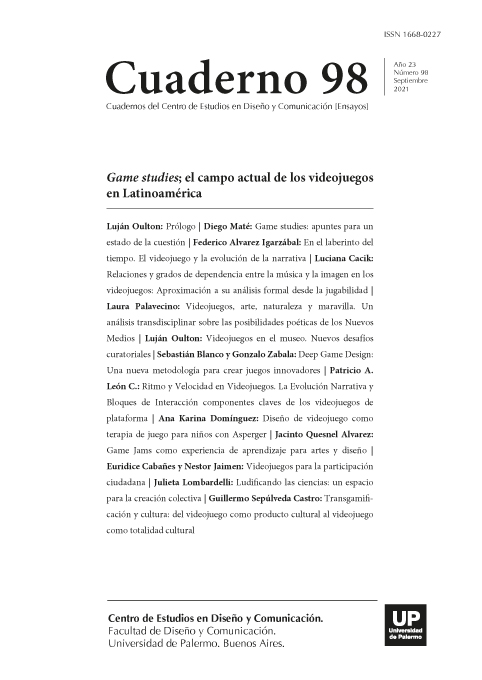En el laberinto del tiempo. El videojuego y la evolución de la narrativa
Résumé
Resumen: Los videojuegos ofrecen la opción de guardar y cargar partidas, permitiendo a los jugadores retroceder en el tiempo del juego. Cada vez que un evento no deseado tiene lugar, estos pueden cargar una partida previa y jugar una porción del juego nuevamente para obtener el resultado anhelado. Dos desafíos surgen de esta mecánica a la hora de contar historias: 1) La capacidad de deshacer eventos es incompatible con la tragedia y 2) emerge una paradoja temporal: Al volver atrás en el tiempo, el jugador conoce el futuro. El personaje que este controla no puede poseer ese conocimiento porque fue restablecido con el resto del mundo ficcional. Pero, dado que es controlado por el jugador, se comporta como si lo tuviera.
Références
Aarseth, E.J. (1999). Aporia and Epiphany in Doom and The Speaking Clock. The Temporality of Ergodic Art. En M.L. Ryan (Ed.), Cyberspace Textuality. Computer Technology and Literary Theory (pp. 31-41). Bloomington, Indiana: Indiana University Press.
Albert, T., Ramis, H. (Productores), & Ramis H. (Director). (1993). Groundhog Day [cinta cinematográfica]. Estados Unidos: Columbia Pictures.
Alvarez Igarzábal, F. (2016). The Groundhog Day Effect. Iterations in Virtual Space. En S. Höltgen & J.C. van Treeck (Eds.), Time to Play. Zeit und Computerspiel (pp. 225-246). Glückstadt: Verlag Werner Hülsbusch.
Berghammer, B. (2009). Changing the Game. The Quantic Dream Heavy Rain Interview Part Two. G4TV. Recuperado de http://www.g4tv.com/games/ps3/36147/heavy-rain/articles/68230/Changing-The-Game-The-Quantic-Dream-Heavy-Rain-Interview-Part-Two/
Borges, J.L. (2013 [1941]). Jorge Luis Borges. Cuentos Completos. Barcelona: Penguin Random House.
Brooker, C. (Writer), & Slade, D. (Director). (2018). Black Mirror: Bandersnatch [episodio de serie de televisión]. En McLean (Executive Producer), Black Mirror, Reino Unido: Netflix.
Bush, V. (2003 [1945]). As We May Think. En N. Wardrip-Fruin & N. Montfort (Eds.), The New Media Reader (pp. 35-47). Cambridge: MIT Press.
Cortázar, J. (2006 [1963]). Rayuela. Madrid: Punto de Lectura.
Crawford, C. (2003). Interactive Storytelling. En M.J.P. Wolf & B. Perron (Eds.), The Video Game Theory Reader (pp. 259-273). New York: Routledge. (s.f.). Storytron. Recuperado de https://www.storytron.com/
Engelbart, D. (2003 [1962]). Augmenting Human Intellect. A Conceptual Framework. En N. Wardrip-Fruin & N. Montfort (Eds.), The New Media Reader (pp. 95-108). Cambridge: MIT Press. GDC. (2013, Marzo). The Future of Storytelling: How Medium Shapes Story [video]. Recuperado de https://www.youtube.com/watch?v=BjrO-di22v8
Guerilla Games. (2017). Horizon Zero Dawn [videojuego]. Países Bajos: Sony Interactive Entertainment.
Hitchens, M. (2006). Time and Computer Games or “No, That’s not What Happened”. IE ’06 Proceedings of the 3rd Australasian Conference on Interactive entertainment, 44-51. Recuperado de https://dl.acm.org/citation.cfm?id=1231902
Jenkins, H. (2004). Game Design as Narrative Architecture. En N. Wardrip-Fruin & P. Harrigan (Eds.), First Person. New Media as Story, Performance, and Game (pp. 118-130). Cambridge: MIT Press.
Juul, J. (2004). Introduction to Game Time / Time to Play. An Examination of Game Temporality. En N. Wardrip-Fruin & P. Harrigan (Eds.), First Person. New Media as Story, Performance, and Game (pp. 131-142). Cambridge, Massachusetts: MIT Press, 2004.
Juul, J. (2005). Half-Real. Video Games between Real Rules and Fictional Worlds. Cambridge: MIT Press.
Kelly, N. (2012). David Cage: “I remember how scared we were”. VideoGamer. Recuperado de: http://www.videogamer.com/ps3/heavy_rain/news/david_cage_i_remember_how_ scared_we_were.html
Licklider, J.C.R. (2003 [1960]). Man-Computer Symbiosis. En N. Wardrip-Fruin & N. Montfort (Eds.), The New Media Reader (pp. 73-82). Cambridge: MIT Press.
Malloy, J. (1995 [1986]). Uncle Roger. Recuperado de https://people.well.com/user/jmalloy/ uncleroger/partytop.html Metacritic. (s.f.). Red Dead Redemption. Recuperado de https://www.metacritic.com/game/xbox-360/red-dead-redemption
Montfort, N. (2003). Introduction. The Garden of Forking Paths. En N. Wardrip-Fruin & N. Montfort (Eds.), The New Media Reader (pp. 29-30).
Cambridge: MIT Press. Murray, J. (2003). Inventing the Medium. En N. Wardrip-Fruin & N. Montfort (Eds.), The New Media Reader (pp. 3-11).
Cambridge: MIT Press. Murray, J. (1997). Hamlet on the Holodeck. The Future of Narrative in Cyberspace. Cambridge: MIT Press. Nabokov, V. (2003 [1962]). Pálido Fuego. Barcelona: Anagrama.
Nelson, T. (2003 [1965]). A File Structure for the Complex, the Changing, and the Indeterminate. En N. Wardrip-Fruin & N. Montfort (Eds.), The New Media Reader (pp. 134-145).
Cambridge: MIT Press. Nintendo. (1985). Super Mario Bros. Japón: Nintendo.
Nitsche, M. (2007). Mapping Time in Video Games. Situated Play. Proceedings of DiGRA 2007 Conference, 145-151. Recuperado de http://homes.lmc.gatech.edu/~nitsche/download/Nitsche_DiGRA_07.pdf
O’Dwyer, D. (2016). David Cage Interview at the E3 2016 Stage Show. Gamespot. Recuperado de https://www.gamespot.com/videos/david-cage-interview-at-the-e3-2016-stageshow/2300-6432977/
Quantic Dream. (2010). Heavy Rain [videojuego]. Francia: Sony Computer Entertainment.
Quantic Dream. (2013). Beyond: Two Souls [videojuego]. Francia: Sony Computer Entertainment.
Quantic Dream. (2018). Detroit: Become Human [videojuego]. Francia: Sony Interactive Entertainment.
Rabyd, B. (1996). Sunshine 69. Recuperado de http://sunshine69.com/noflash.html
Rockstar San Diego. (2010). Red Dead Redemption [videojuego]. Estados Unidos: Rockstar Games.
Taito. (1976). Space Invaders [videojuego]. Japón: Taito. Take Two Interactive. (2015, Agosto 18). SEC Filings. Recuperado de http://ir.take2games.com/phoenix.zhtml?c=86428&p=irol-SECText&TEXT=aHR0cDovL2FwaS50ZW5rd2l6YXJkLmNvbS9maWxpbmcueG1sP2lwYWdlPTEwNDQ0MDQ2JkRTRVE9MCZTRVE9MCZTUURFU0M9U0VDVElPTl9FTlRJUkUmc3Vic2lkPTU3
Toy, M. & Wichman, G. (1980). Rogue [videojuego]. Estados Unidos: Epyx.
Wittmann, M. (2009). The Inner Experience of Time. Philosophical Transactions of The Royal Society 364, 1955-1967. https://doi.org/10.1098/rstb.2009.0003
Wittmann, M. (2011). Moments in Time. Frontiers in Integrative Neuroscience 5, article 66. https://doi.org/10.3389/fnint.2011.00066
Wolf, M.J.P. (2002). Time in the Video Game. En M.J.P. Wolf (Ed.), The Medium of the Video Game (pp. 77-91). Austin: University of Texas Press.
Los autores/as que publiquen en esta revista ceden los derechos de autor y de publicación a "Cuadernos del Centro de Estudios de Diseño y Comunicación", Aceptando el registro de su trabajo bajo una licencia de atribución de Creative Commons, que permite a terceros utilizar lo publicado siempre que de el crédito pertinente a los autores y a esta revista.


